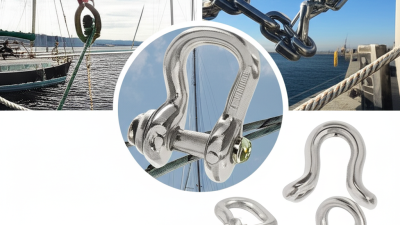In today's rapidly evolving industrial landscape, the significance of stainless steel shackles cannot be overstated. These versatile components are increasingly being integrated across a variety of applications, from maritime and construction sectors to heavy lifting and rigging. According to a recent report by ResearchAndMarkets, the global shackles market is projected to reach USD 1.5 billion by 2027, driven by the rising demand for durable and corrosion-resistant materials. Stainless steel shackles, known for their strength, resilience, and resistance to harsh environments, are becoming the preferred choice for developers and engineers aiming to enhance safety and efficiency in their projects. This essential guide aims to uncover the multifaceted applications of stainless steel shackles, highlighting their critical role in modern engineering and construction practices.

Stainless steel shackles are essential components in various industries, providing reliable strength and versatility in securing loads. There are three primary types of stainless steel shackles: bow shackles, dee shackles, and screw pin shackles. Bow shackles are designed for multi-directional loads, making them ideal for applications like marine rigging and lifting. According to a recent industry report by Research and Markets, the global demand for shackles is expected to grow at a CAGR of 5.3% from 2021 to 2026, driven by increasing needs in construction and shipping sectors.
Dee shackles, known for their high strength-to-weight ratio, are commonly used in heavy lifting operations where minimal horizontal load is present. In contrast, screw pin shackles are easy to undo and can be quickly secured, making them popular in emergency recovery operations. The versatility of these shackles is underscored by their material properties; stainless steel offers corrosion resistance, making them suitable for harsh environments. A study by Allied Market Research highlights that nearly 50% of industries prefer stainless steel shackles due to their durability and safety features.
When selecting stainless steel shackles for your project, one of the foremost factors to consider is the application environment. Stainless steel is renowned for its corrosion resistance, particularly in marine or industrial settings where exposure to moisture and corrosive substances is prevalent. Therefore, choosing a shackle made from high-grade stainless steel, such as 316 or 304, can significantly enhance the longevity and durability of your rigging system.
Another critical aspect to pay attention to is the shackle's load rating. Each shackle comes with a specified working load limit (WLL), which ensures that it can handle the expected loads without risking failure. It's essential to account for dynamic loads and shock-loading conditions that may exceed typical weights. Ensuring you have a safety factor built into your choice will provide additional reliability and peace of mind. Additionally, the type of shackle—whether Lifting, Anchor, or Bow—should also align with your specific project needs, as each design serves different purposes and offers various benefits.
When it comes to installing and using stainless steel shackles, safety and versatility are paramount. The first essential step in the installation process is to assess your equipment and the specific tasks at hand. Ensure you select the right size and type of shackle to match the working load limit of your application. Conduct a thorough inspection of the shackles for any signs of wear or damage before use, as this can jeopardize safety during operation.
Once you have chosen the appropriate shackles, the next step involves secure attachment. Begin by aligning the shackle with the attachment points of your equipment, ensuring that the pin is oriented properly. Tighten the pin securely, but be cautious not to overtighten, as this could lead to potential failure during use. After installation, it is wise to perform a test lift or pull to assess the stability of the shackle under load. Regular maintenance, including cleaning and lubrication, will help maintain the integrity of stainless steel shackles, ensuring they remain effective and reliable in various modern applications, from off-road vehicles to marine environments.
Regular maintenance of stainless steel shackles is crucial for ensuring their longevity and optimal performance, especially in applications subject to heavy loads and dynamic forces. According to industry reports, roughly 20% of equipment failures can be attributed to inadequate maintenance practices. This highlights the importance of routinely inspecting shackle links and bushings for signs of wear and corrosion. Regular checks can prevent unexpected breakdowns and improve safety for equipment users.
In the realm of RV maintenance, shackles play a critical role in the suspension system. Many RV owners focus primarily on tires and brakes, neglecting the importance of shackles. Research indicates that over 30% of RV-related incidents stem from suspension system failures, underscoring the need for diligent inspection practices. Replacing worn shackles and ensuring proper lubrication can enhance the durability of these components, further extending the lifespan of the entire suspension assembly. Thus, systematic maintenance not only contributes to safety but also promotes better performance and reliability of RVs and other vehicles utilizing stainless steel shackles.
Stainless steel shackles have become indispensable tools across a variety of industries, showcasing their versatility and reliability. From marine applications to construction and even in the automotive sector, these robust connectors provide a secure means of attachment that withstands harsh environments. Their corrosion-resistant properties make them ideal for use in settings exposed to saltwater, chemicals, or extreme weather conditions.
**Tips:** When selecting stainless steel shackles for your project, always consider the workload limit. Overloading can lead to fatigue and potential failure. Additionally, ensure the shackle is appropriately sized for your application to guarantee optimal performance and security.
Moreover, innovations in stainless steel shackle design have led to enhancements in functionality. Quick-release mechanisms and locking systems have made them safer and easier to use, which is particularly beneficial in emergency situations. Industries are continuously exploring new ways to integrate shackles into their operations, proving that these simple yet effective tools are more than just hardware—they are essential components in modern engineering solutions.
**Tips:** Regular maintenance of shackles in your equipment is crucial to prolong their lifespan. Inspect them frequently for signs of wear and replace any damaged shackles to ensure safety and reliability in your operations.
